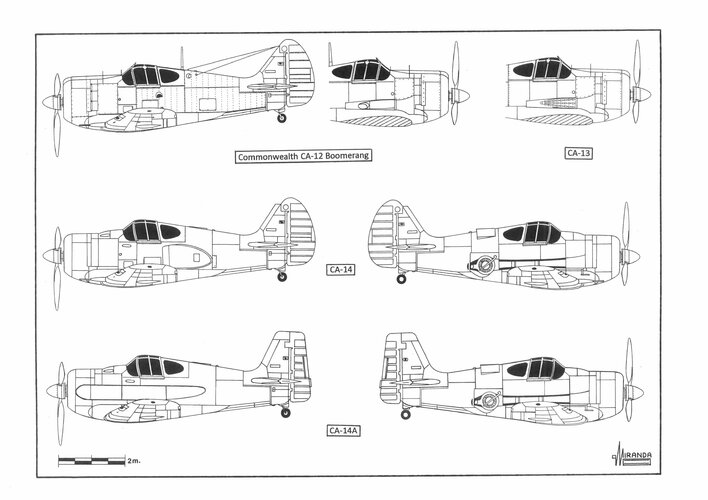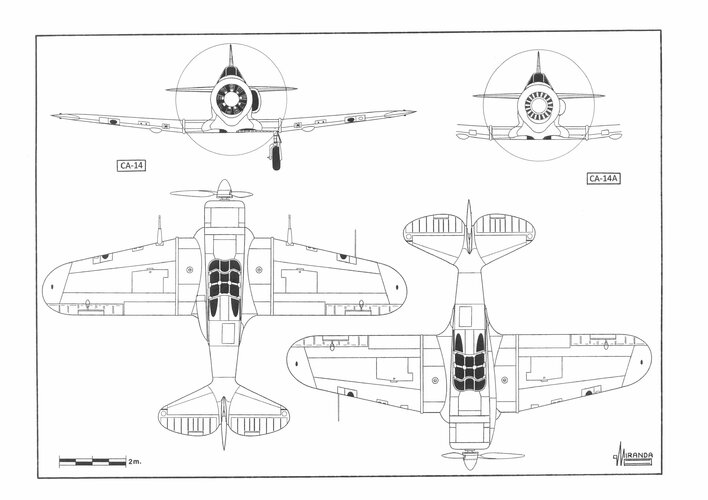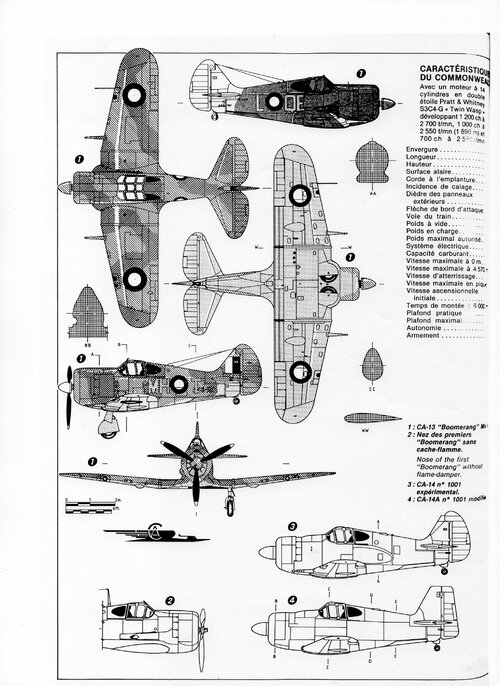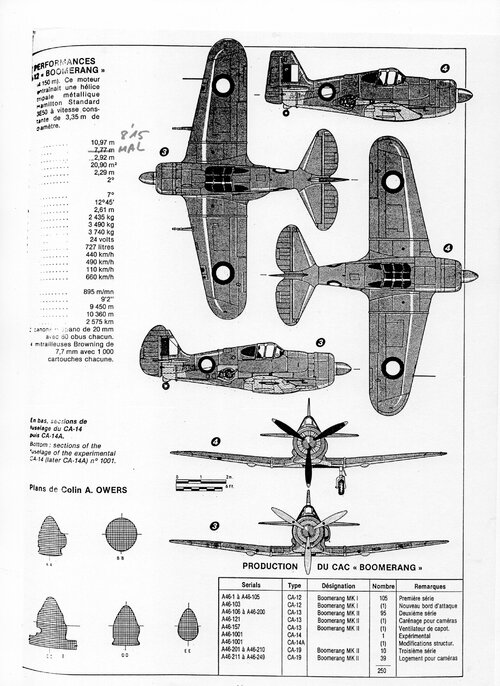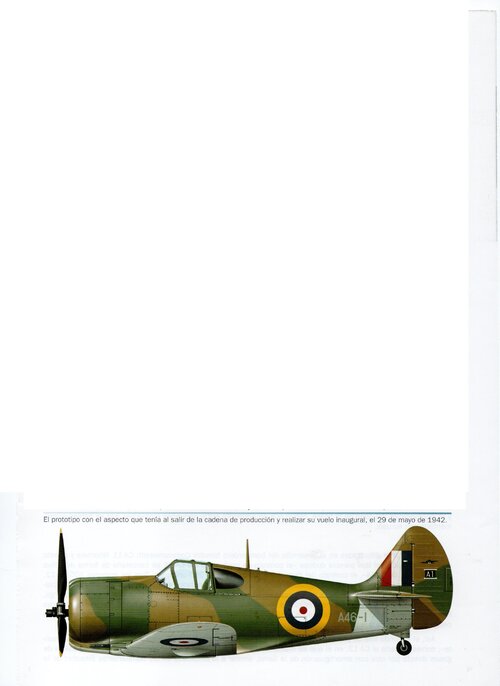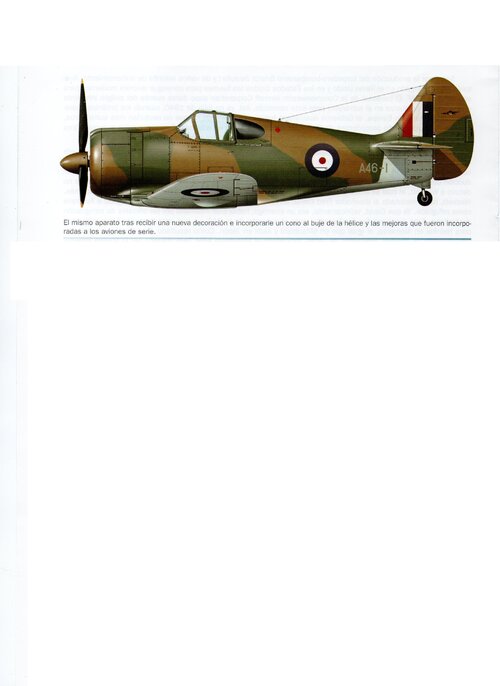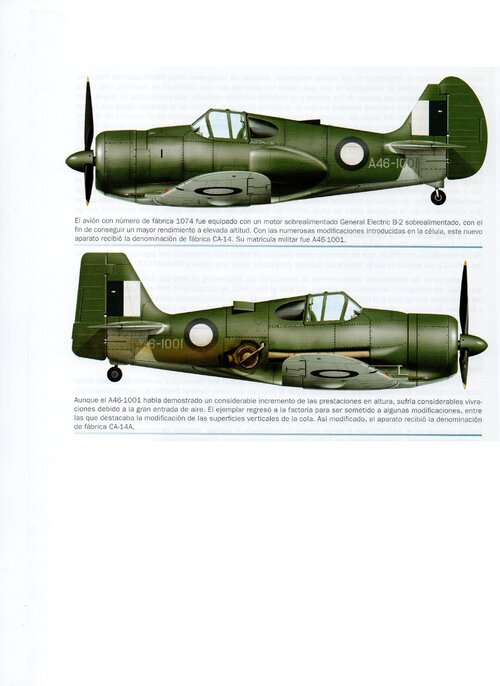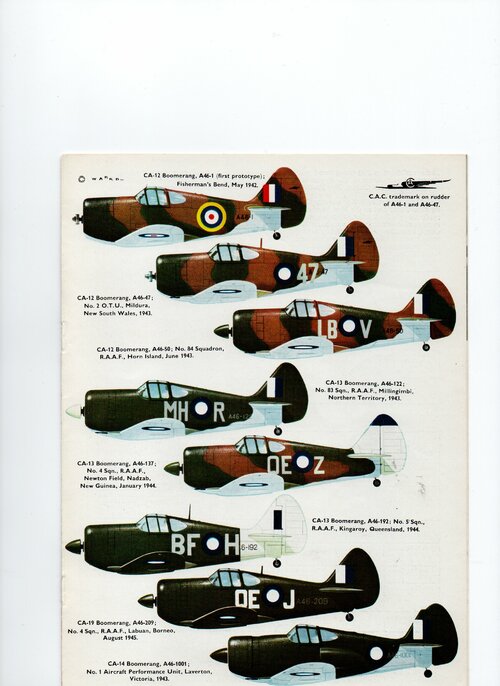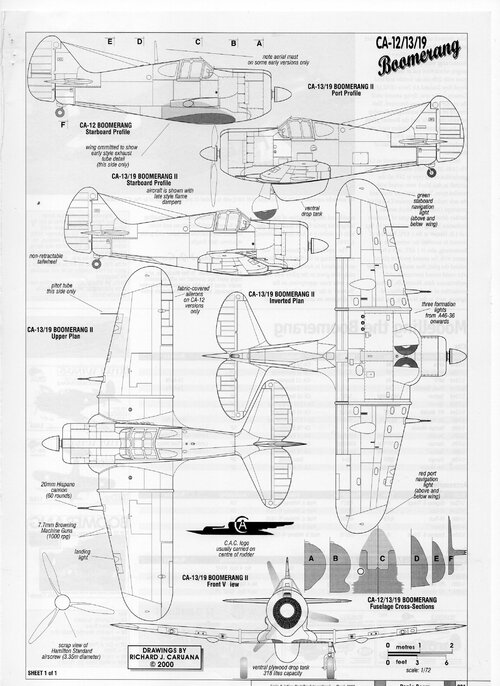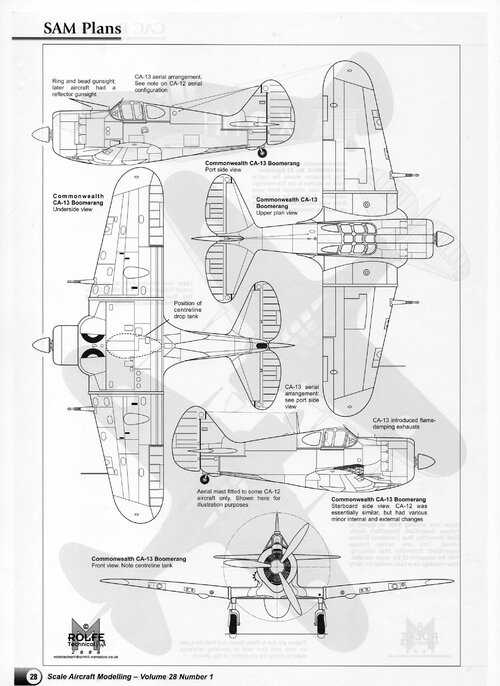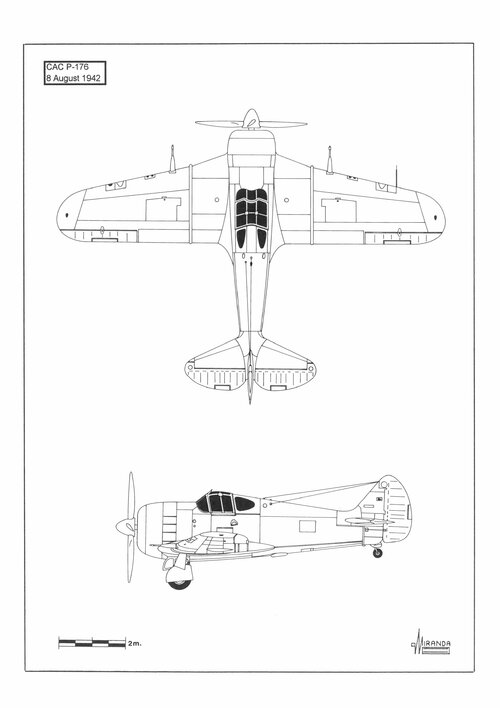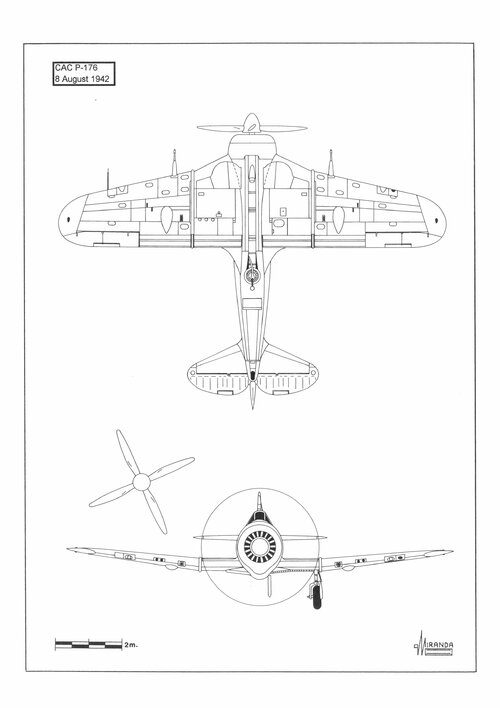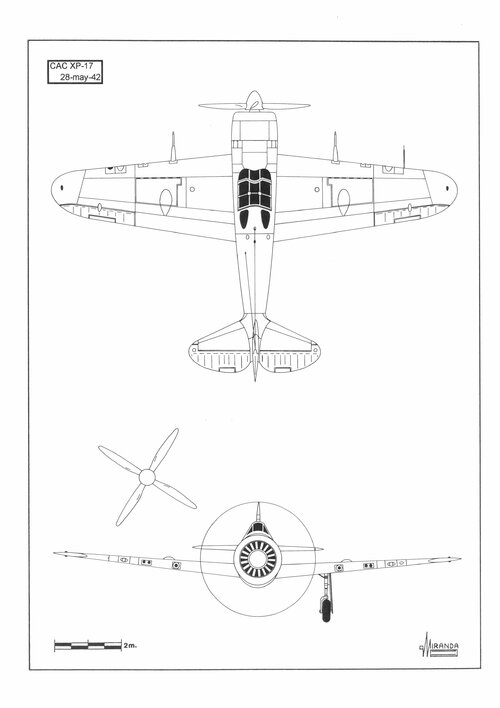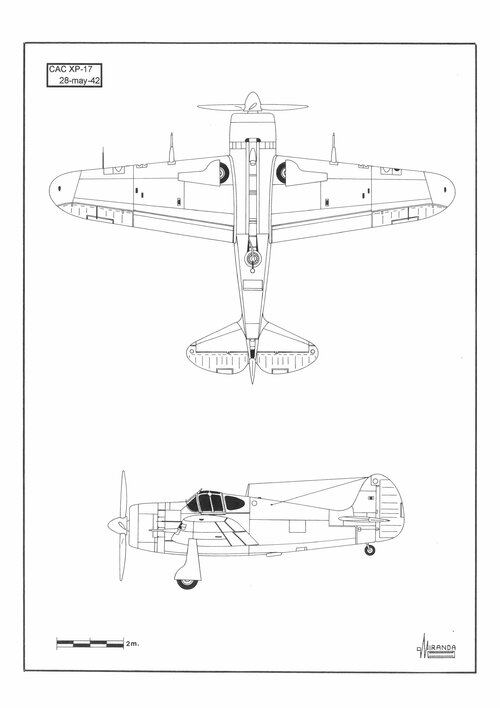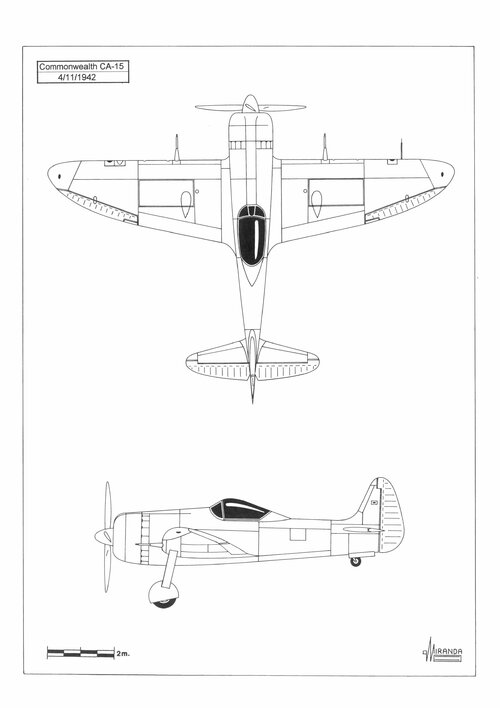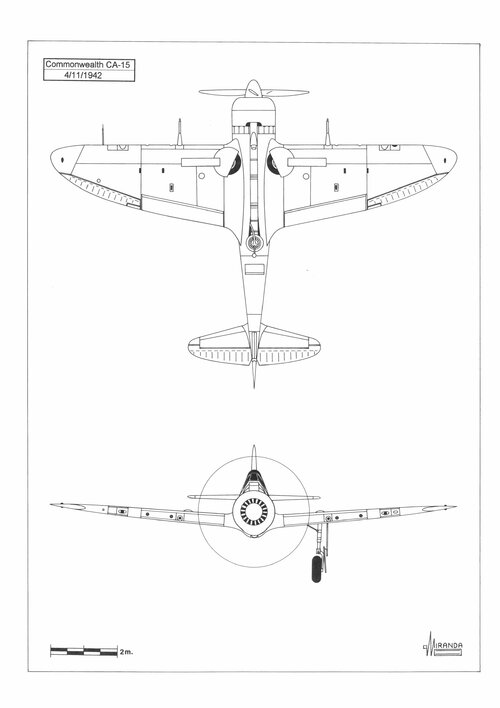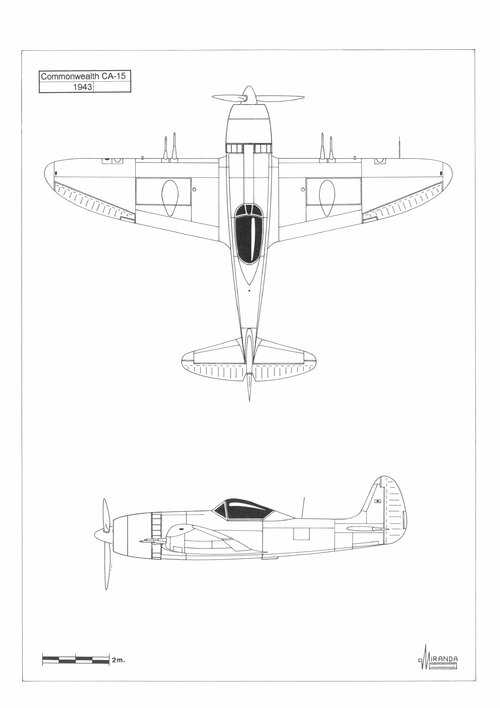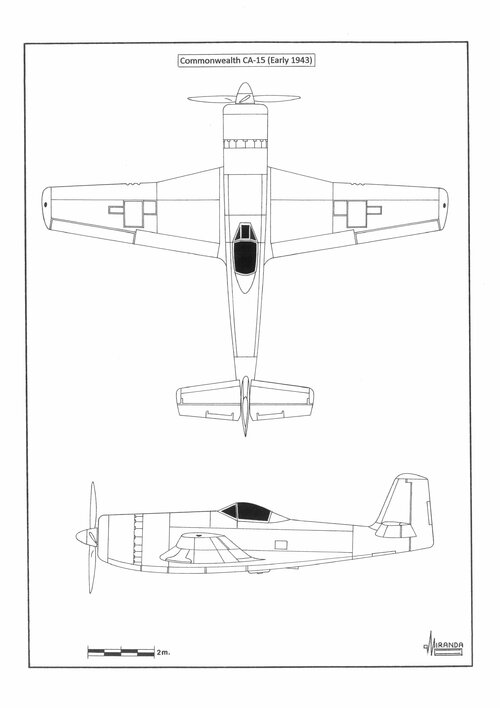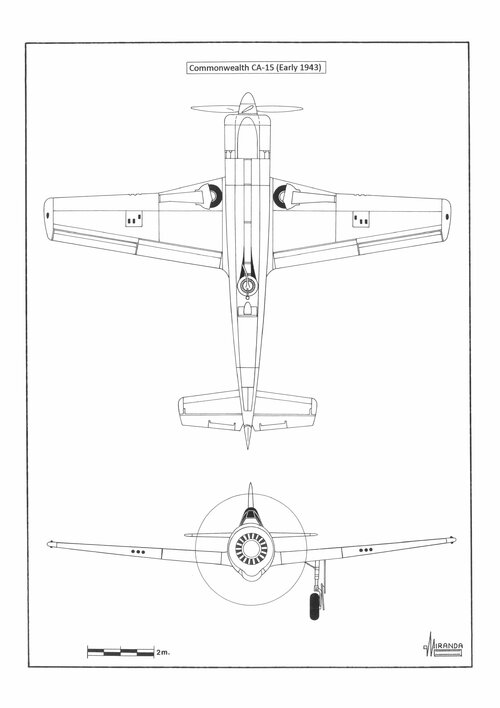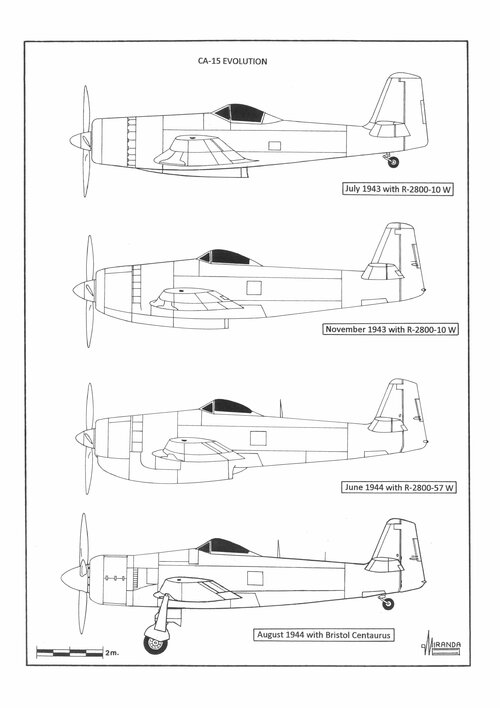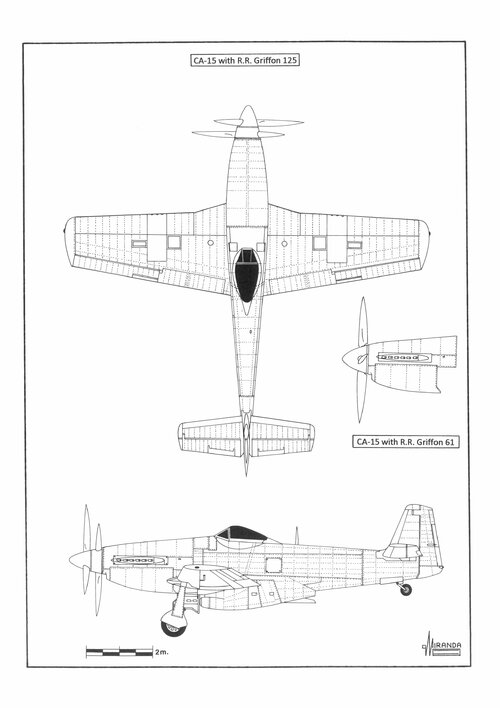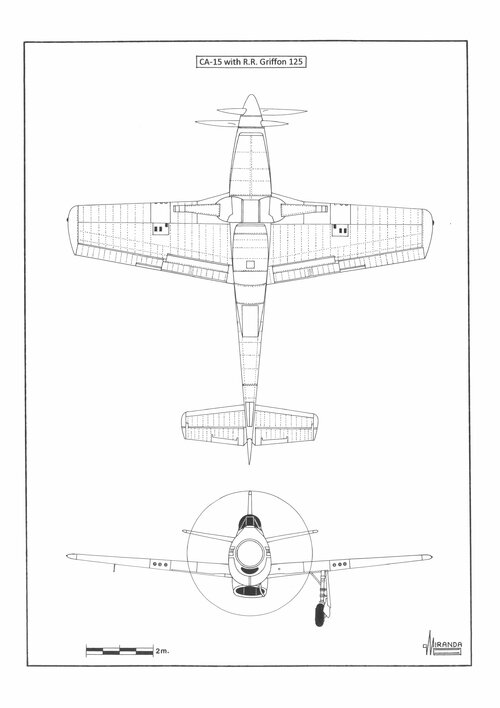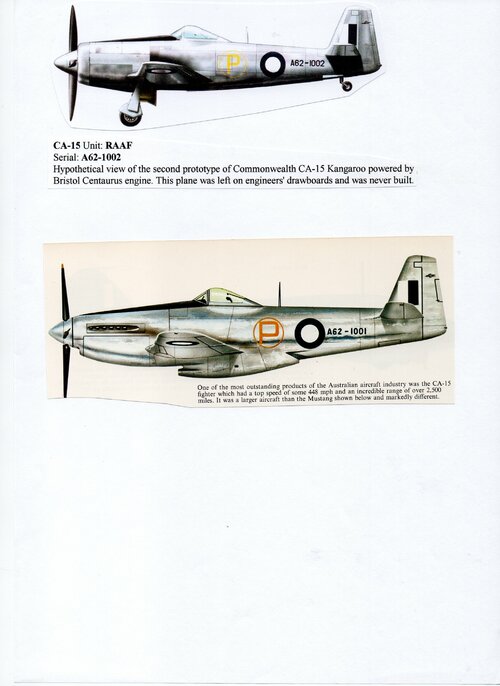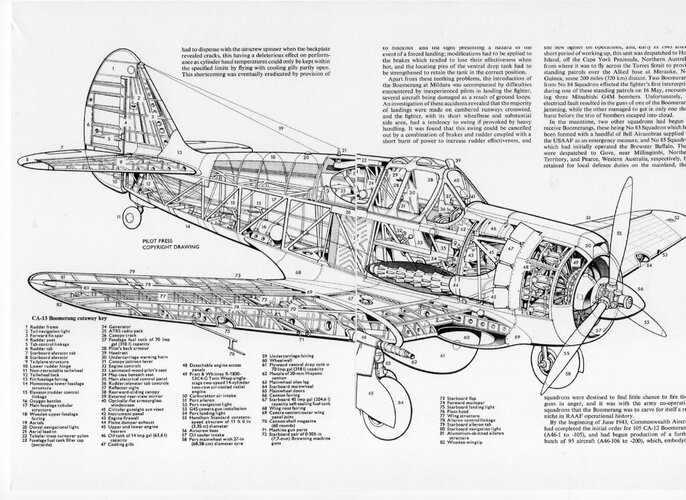In July 1940 the hounded British government warns the Australians of an imminent embargo of any aviation materials.
On 10 December 1941 the capital ships of the Royal Navy H.M.S. Prince of Wales and H.M.S. Repulse are sunk by Japanese airplanes. On 21 December of the same month, the firm Commonwealth Aircraft Corporation (CAC) receives the order from the Australian Government to design a ‘Panic Fighter’ starting from the ‘Wirraway’ trainer airframe (the Australian version of the North American T-6 produced under licence by the CAC) and from the most powerful engine available in the country, the 1,200 hp Pratt & Whitney R-1830 S3C4-G.
On 15 February 1942 Singapore surrenders to the Imperial Japanese Army. On 18 February, the Australian War Cabinet authorized an order for 105 units of the new ‘stop-gap’ fighter under the designation CA-12 ‘Boomerang’ (490 kph). The next day, Japanese naval airplanes attacked Port Darwin causing serious damage. On 9 March of the same year, the island of Java is invaded by Japanese troops and the Allies dissolve the naval force ‘ABDA’. On 9 April 1942, Japanese naval airplanes attacked Ceylon and the British Eastern Fleet must move to the base of Kilindini in the eastern coast of Africa.
The ‘Boomerang’ first flight tests were performed on 29 May 1942. The new fighter showed excellent performance for low altitude flight, being superior to their American equivalents NA-50 and NA-68. On the other hand, its engine (originally designed to go with the Beaufort torpedo bombers) was optimized to operate at low altitude and reached highest power at 4,900 ft. However, the ‘Boomerang’ proved to lack the right performances for medium altitude interception of standard Japanese bombers and was used for ground attack duties only.
In August 1942 the RAAF received four P-43 A-1 and two P-43D ‘Lancers’ from the USAAF, plus two more P-43D in November. These airplanes had the same engine than the ‘Boomerang’ but they were also equipped with a belly mounted turbo-supercharger General Electric B-2 that considerably improved its performances at high altitude. Unfortunately, the Americans had been extremely reluctant to provide B-2 superchargers, 125 of which had been approved by Lend-Lease at the beginning of 1942. The reasons behind this political attitude were the plans of the North American company to manufacture the P-51 Mustang, propelled by a British Merlin engine, in Australia.
Even so, the CAC continued improving the ‘Boomerang’ afraid that the unstoppable advance of the Teikoku Kaigun through the Pacific could interrupt the supplying routes with the USA. By the end of 1942 the CA-12 was modified by installing a B-2 turbocharger (coming from a ‘Liberator’) and a Harrison intercooler (coming from a ‘Fortress’) mounted in the rear fuselage on the starboard side. The prototype flew on 13 January 1943 as CA-14, reaching a maximum speed of 560 km/h at 8,600 m powered by one 1,700 hp Wright Cyclone R-2600 engine, driving a 3.35 m diameter Curtiss Electric, three-bladed, constant-speed propeller. By comparison, the standard CA-12 could achieve just 490 km/h at 4,700 m.
In May 1943 the engine was replaced by a non-turbocharged R-2000 (basically a wartime modification of the R-1830 extended to 2000 cubic inch capacity) with a General Electric B-9 turbocharger, square fin and rudder and geared engine cooling fan ‘Fw 190 style’. This version was named CA-14A.
On 28 May 1942 the CAC proposed to build an ‘improved Boomerang’ named XP-17, with modified tail surfaces and completely new wing, propelled by a 1,700 hp Wright Cyclone R-2600-12 (with ten-bladed cooling fan and B-9 ventral turbo- supercharger) driving a Hamilton Standard four-bladed wooden propeller.
On 8 August 1942 the P-176 project sees the light, a new and more conservative model based on a ‘Boomerang’ airframe with new streamlined leading edges, 1,900 hp R-2600-20 engine, four-bladed wooden propeller, cooling fan and B-13 ventral turbocharger. The project was discontinued in February 1943.
To meet the RAAF Specification 2/42, the CAC was instructed to design a new fighter named CA-15 in October 1942 to be propelled by the 2,000 hp Pratt Whitney R-2800-21 air cooled radial engine with single-stage/single-speed supercharger and General Electric B-9 exhaust-driven turbocharger. It would soon be available as it used same power plant than the American Thunderbolts, Hellcats, Corsairs and Marauders. On 4 November 1942 ‘Report No. A-87’ was published depicting a first design of the CA-15, fitted with semi-elliptical wings, R-2800-21 engine with four-bladed wooden propeller, four 0.303 in Browning Mk II machine guns and two 20 mm Hispano Mk II cannons.
As it turned out, the R-2800-21 was not available by the beginning of 1943 and the design was modified to adapt it to the 2,100 hp R-2800-43 engine, optimised for medium altitude operations, with single stage/two speed supercharger and liquid cooled Airesearch intercooler. The engine-cowling adopted a more streamlined shape, the propeller was three-bladed, and the ‘Boomerang’ standard armament was replaced by four 20 mm Hispano Mk II cannons and two 0.303 in Browning Mk II machine guns.
By early 1943, the CA-15 was redesigned as high-altitude interceptor, with NACA 66 laminar flow wings and 12.19 m wingspan. The power plant was one 2,180 hp R-2800-10W (with two-speed/two-stage General Electric Type C turbocharger and liquid cooled intercooler) driving one CAC four bladed, hydraulically operated, constant speed, wooden propeller of 3.89 m diameter. The proposed armament was six0.50 inches Colt Browning machine guns mounted on the wing and the estimated maximum speed was of 702 kph.
To meet the RAAF Specification 2/43, calling for a low-medium altitude long range fighter, the CAC proposed the August 1943 design, the turbocharger was removed, and the engine was fitted with a single-stage, two-speed supercharger. Four months later, the supercharger site was changed, being installed under the engine in one enormous cowling with large exhaust pipe under the fuselage. A configuration that had already been tested in the Curtiss XF14C.
On May 1944 the CAC was disappointed to learn that the 10W engine was no longer in production and considered its replacement by a 2,800 hp R-2800-57W with single-speed/ single-stage supercharger and GE Type CH-5 turbo-supercharger. On June, the cooling fan was replaced by a ‘Thunderbolt style’ airscoop placed under the engine. The estimated maximum speed was 796 kph.
On August the CA-15 prototype was around 50 percent complete and the availability of 57W engine became doubtful. The 2,500 hp Bristol Centaurus engine was considered but its performance would have been substantially reduced from that of the R-2800-57W. They finally selected the 2,440 hp Rolls-Royce Griffon 125 twelve-cylinder, Vee, liquid-cooled engine (with two-stage/three-speed supercharger) driving three-bladed contra-rotating airscrews. For its installation in an airframe that had been designed for a radial engine, it was necessary to build a new streamlined cowling.
The cooling system consisted of a Morris single-row intercooler, with a three-row main radiator, and was packaged in a large ‘Mustang style’ ventral fairing with frontal scoop. The Griffon 125 turned out to have the smallest frontal surface, but when the CA-15 prototype was completed, the engine had not yet reached its serial production stage and Rolls-Royce decided to replace it by two copies of the weaker version Griffon 61. The two available engines arrived in Australia in April 1945.
The Griffon 61 (2,035 hp) was fitted with two-stage, two-speed supercharger and drove a Dowty-Rotol compressed wood, four-bladed propeller of 3.81 m diameter. Its installation in the CA-15 reduced the overall length from 11.51 m to 11.04 m. By February 1946 the prototype was completed, performing its first flight on March 4. It was used for a very limited test programme and gained one speed record achieving 808.2 kph flying over Melbourne on 25 May 1948. The CA-15 would have ranked amongst the best fighters in the Pacific had the war been prolonged. Superseded by the jet age, was scrapped in 1950.
Books
Francillon, R., The Commonwealth Boomerang (Profile Number 178)
Green, W., The Complete Book of Fighters (Smithmark, 1994)
Pentland, G., Aircraft of the RAAF 1921-71 (Kookaburra Publications, 1971)
Thetford, O., Aircraft of the Fighting Powers, Vol.7 (Argus Books, 1979)
Wilson, W., The Wirraway, Boomerang & CA-15 in Australian Service (Aerospace Publications, 1991)
Publications
Darbyshire, D., ’Full Red Circle’ (Wingspan, January 2002)
Donald, D., ’Commonwealth CA-15’ (Wings of Fame Vol.4)
Green, W., ’Antipodean Finale’ (Air Enthusiast/October 1972)
Guttman, J., ’Aerial Oddities’ (Aviation History, May 1997)
Hourigan, R., ’Vintage Australians’ (APMA Number 3, 1995)
Millot, B., ’Le Commonwealth Boomerang’ (Le Fanatique de l’Aviation Nº 190 and 234)
Vella, J., ’From Fisherman Bend’ (Air Enthusiast Number 61)
On 10 December 1941 the capital ships of the Royal Navy H.M.S. Prince of Wales and H.M.S. Repulse are sunk by Japanese airplanes. On 21 December of the same month, the firm Commonwealth Aircraft Corporation (CAC) receives the order from the Australian Government to design a ‘Panic Fighter’ starting from the ‘Wirraway’ trainer airframe (the Australian version of the North American T-6 produced under licence by the CAC) and from the most powerful engine available in the country, the 1,200 hp Pratt & Whitney R-1830 S3C4-G.
On 15 February 1942 Singapore surrenders to the Imperial Japanese Army. On 18 February, the Australian War Cabinet authorized an order for 105 units of the new ‘stop-gap’ fighter under the designation CA-12 ‘Boomerang’ (490 kph). The next day, Japanese naval airplanes attacked Port Darwin causing serious damage. On 9 March of the same year, the island of Java is invaded by Japanese troops and the Allies dissolve the naval force ‘ABDA’. On 9 April 1942, Japanese naval airplanes attacked Ceylon and the British Eastern Fleet must move to the base of Kilindini in the eastern coast of Africa.
The ‘Boomerang’ first flight tests were performed on 29 May 1942. The new fighter showed excellent performance for low altitude flight, being superior to their American equivalents NA-50 and NA-68. On the other hand, its engine (originally designed to go with the Beaufort torpedo bombers) was optimized to operate at low altitude and reached highest power at 4,900 ft. However, the ‘Boomerang’ proved to lack the right performances for medium altitude interception of standard Japanese bombers and was used for ground attack duties only.
In August 1942 the RAAF received four P-43 A-1 and two P-43D ‘Lancers’ from the USAAF, plus two more P-43D in November. These airplanes had the same engine than the ‘Boomerang’ but they were also equipped with a belly mounted turbo-supercharger General Electric B-2 that considerably improved its performances at high altitude. Unfortunately, the Americans had been extremely reluctant to provide B-2 superchargers, 125 of which had been approved by Lend-Lease at the beginning of 1942. The reasons behind this political attitude were the plans of the North American company to manufacture the P-51 Mustang, propelled by a British Merlin engine, in Australia.
Even so, the CAC continued improving the ‘Boomerang’ afraid that the unstoppable advance of the Teikoku Kaigun through the Pacific could interrupt the supplying routes with the USA. By the end of 1942 the CA-12 was modified by installing a B-2 turbocharger (coming from a ‘Liberator’) and a Harrison intercooler (coming from a ‘Fortress’) mounted in the rear fuselage on the starboard side. The prototype flew on 13 January 1943 as CA-14, reaching a maximum speed of 560 km/h at 8,600 m powered by one 1,700 hp Wright Cyclone R-2600 engine, driving a 3.35 m diameter Curtiss Electric, three-bladed, constant-speed propeller. By comparison, the standard CA-12 could achieve just 490 km/h at 4,700 m.
In May 1943 the engine was replaced by a non-turbocharged R-2000 (basically a wartime modification of the R-1830 extended to 2000 cubic inch capacity) with a General Electric B-9 turbocharger, square fin and rudder and geared engine cooling fan ‘Fw 190 style’. This version was named CA-14A.
On 28 May 1942 the CAC proposed to build an ‘improved Boomerang’ named XP-17, with modified tail surfaces and completely new wing, propelled by a 1,700 hp Wright Cyclone R-2600-12 (with ten-bladed cooling fan and B-9 ventral turbo- supercharger) driving a Hamilton Standard four-bladed wooden propeller.
On 8 August 1942 the P-176 project sees the light, a new and more conservative model based on a ‘Boomerang’ airframe with new streamlined leading edges, 1,900 hp R-2600-20 engine, four-bladed wooden propeller, cooling fan and B-13 ventral turbocharger. The project was discontinued in February 1943.
To meet the RAAF Specification 2/42, the CAC was instructed to design a new fighter named CA-15 in October 1942 to be propelled by the 2,000 hp Pratt Whitney R-2800-21 air cooled radial engine with single-stage/single-speed supercharger and General Electric B-9 exhaust-driven turbocharger. It would soon be available as it used same power plant than the American Thunderbolts, Hellcats, Corsairs and Marauders. On 4 November 1942 ‘Report No. A-87’ was published depicting a first design of the CA-15, fitted with semi-elliptical wings, R-2800-21 engine with four-bladed wooden propeller, four 0.303 in Browning Mk II machine guns and two 20 mm Hispano Mk II cannons.
As it turned out, the R-2800-21 was not available by the beginning of 1943 and the design was modified to adapt it to the 2,100 hp R-2800-43 engine, optimised for medium altitude operations, with single stage/two speed supercharger and liquid cooled Airesearch intercooler. The engine-cowling adopted a more streamlined shape, the propeller was three-bladed, and the ‘Boomerang’ standard armament was replaced by four 20 mm Hispano Mk II cannons and two 0.303 in Browning Mk II machine guns.
By early 1943, the CA-15 was redesigned as high-altitude interceptor, with NACA 66 laminar flow wings and 12.19 m wingspan. The power plant was one 2,180 hp R-2800-10W (with two-speed/two-stage General Electric Type C turbocharger and liquid cooled intercooler) driving one CAC four bladed, hydraulically operated, constant speed, wooden propeller of 3.89 m diameter. The proposed armament was six0.50 inches Colt Browning machine guns mounted on the wing and the estimated maximum speed was of 702 kph.
To meet the RAAF Specification 2/43, calling for a low-medium altitude long range fighter, the CAC proposed the August 1943 design, the turbocharger was removed, and the engine was fitted with a single-stage, two-speed supercharger. Four months later, the supercharger site was changed, being installed under the engine in one enormous cowling with large exhaust pipe under the fuselage. A configuration that had already been tested in the Curtiss XF14C.
On May 1944 the CAC was disappointed to learn that the 10W engine was no longer in production and considered its replacement by a 2,800 hp R-2800-57W with single-speed/ single-stage supercharger and GE Type CH-5 turbo-supercharger. On June, the cooling fan was replaced by a ‘Thunderbolt style’ airscoop placed under the engine. The estimated maximum speed was 796 kph.
On August the CA-15 prototype was around 50 percent complete and the availability of 57W engine became doubtful. The 2,500 hp Bristol Centaurus engine was considered but its performance would have been substantially reduced from that of the R-2800-57W. They finally selected the 2,440 hp Rolls-Royce Griffon 125 twelve-cylinder, Vee, liquid-cooled engine (with two-stage/three-speed supercharger) driving three-bladed contra-rotating airscrews. For its installation in an airframe that had been designed for a radial engine, it was necessary to build a new streamlined cowling.
The cooling system consisted of a Morris single-row intercooler, with a three-row main radiator, and was packaged in a large ‘Mustang style’ ventral fairing with frontal scoop. The Griffon 125 turned out to have the smallest frontal surface, but when the CA-15 prototype was completed, the engine had not yet reached its serial production stage and Rolls-Royce decided to replace it by two copies of the weaker version Griffon 61. The two available engines arrived in Australia in April 1945.
The Griffon 61 (2,035 hp) was fitted with two-stage, two-speed supercharger and drove a Dowty-Rotol compressed wood, four-bladed propeller of 3.81 m diameter. Its installation in the CA-15 reduced the overall length from 11.51 m to 11.04 m. By February 1946 the prototype was completed, performing its first flight on March 4. It was used for a very limited test programme and gained one speed record achieving 808.2 kph flying over Melbourne on 25 May 1948. The CA-15 would have ranked amongst the best fighters in the Pacific had the war been prolonged. Superseded by the jet age, was scrapped in 1950.
Bibliography
Books
Francillon, R., The Commonwealth Boomerang (Profile Number 178)
Green, W., The Complete Book of Fighters (Smithmark, 1994)
Pentland, G., Aircraft of the RAAF 1921-71 (Kookaburra Publications, 1971)
Thetford, O., Aircraft of the Fighting Powers, Vol.7 (Argus Books, 1979)
Wilson, W., The Wirraway, Boomerang & CA-15 in Australian Service (Aerospace Publications, 1991)
Publications
Darbyshire, D., ’Full Red Circle’ (Wingspan, January 2002)
Donald, D., ’Commonwealth CA-15’ (Wings of Fame Vol.4)
Green, W., ’Antipodean Finale’ (Air Enthusiast/October 1972)
Guttman, J., ’Aerial Oddities’ (Aviation History, May 1997)
Hourigan, R., ’Vintage Australians’ (APMA Number 3, 1995)
Millot, B., ’Le Commonwealth Boomerang’ (Le Fanatique de l’Aviation Nº 190 and 234)
Vella, J., ’From Fisherman Bend’ (Air Enthusiast Number 61)

